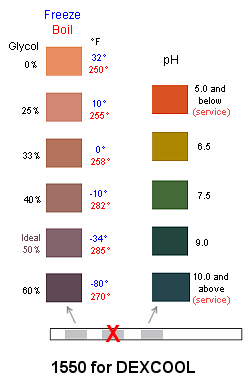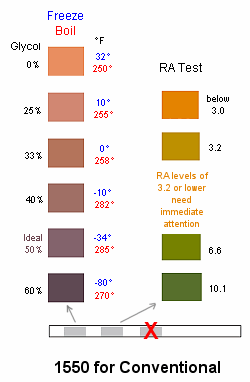|
Please
Contact us for your Technical Questions and to Order
1 (800)
266-4497
or
e-mail
sales@GWRauto.com
|
|
Here are
answers to a few FAQ's
|
What
are some of the common causes and effects of poor coolant?
There
are a wide variety of causes, effects and solutions of problems that might
occur with your antifreeze coolant system. Indeed, there are more than we
can list here. Please review the Coolant Cause-Effect Chart (Coming soon).
|
Why
do I need to measure the freeze point of the antifreeze in my car?
A
50/50 blend of Antifreeze and water will provide freeze protection to -34
degrees and boil over protection to 257 degrees Fahrenheit. In colder
areas of the US protection against block freezing is well known. With the
higher efficiency and operating temperatures of vehicles, providing
adequate boil over protection to prevent the loss of coolant and potential
overheating and engine seizure is a must. Please review the Coolant Chart
for Maintaining 50% Antifreeze (Coming soon).
|
What
results would I expect if I used the test strip in an Ethylene Propylene
Glycol mixture?
The
results will be less than 1 color block conservative. Ethylene Glycol
provides slightly higher freeze protection at like concentrations, and
therefore contributes to a lower freeze point protection. Differences of
less than 1 color block will result.
|
What
results would I expect if I used the test strip in an Ethylene Glycol
mixture?
The
results will be less than 1 color block conservative. Ethylene Glycol
provides slightly higher freeze protection at like concentrations, and
therefore contributes to a lower freeze point protection. Differences of 1
color block will result.
|
Does
Antifreeze do anything other than provide protection from freezing and
boil over?
Antifreeze
coolant has several uses. Foremost is its ability to help remove heat from
an engine. Antifreeze and water have been used extensively since the
1950's as a heat transfer fluid due to its low cost plentiful supply, and
easy and safe handling.
|
What
ways are there to measure freeze point?
In
order of expense and difficulty of use, the lowest to highest are:
 - Test strips - Test strips
 - Hydrometer - Hydrometer
 - Refractometer - Refractometer
|
Can
I use Antifreeze by itself?
Antifreeze
by itself has an insufficient boil over and freeze protection ability.
It's the mixing with water that provides the freeze and boil over
protection. Note that you must not execeed a mixture of more than 70%
antifreeze to 30% water.
|
Can
I use water by itself?
Water
by itself is very corrosive and will not provide the freeze and boil over
protection a combustion engine requires. Again, it is the combining
of water and anti-freeze that creates the protection.
|
What
is corrosion?
Water
by itself is corrosive to metals. The most familiar corrosion is rust, it
develops as metals come in contact with air and water. Corrosion occurs
with the other metals in a cooling system, copper, iron, aluminum etc. A
good antifreeze coolant has an inhibitor package to protect against
corrosion.
|
How
do I know if my antifreeze is protecting the engine against corrosion?
The
easiest way to test antifreeze for corrosion protection is with test
strips. Our strip system tests more than just freeze point, you can
determine if the antifreeze coolant is corrosive and/or has life left to
protect the engine.
|
How
does a test strip work?
Immersion
momentarily into a water and antifreeze solution, of a chemically treated
pad on the end of an inert plastic strip, begins the activation process.
The strip caries a pH indicator, a reserve alkalinity indicator, a
buffering agent and a color reagent pad especially correlated to various
concentrations and freeze points of antifreeze solutions.
|
How
accurate are the test strips?
In
a blind field test of over 200 people using antifreeze and water dilutions
of 25, 33, 40, 45, 50 and 60%, approximately 90% of the readings by the
test strip as interpreted by the people in varying levels of light were
within 10 degrees of the refractometer readings.
|
Does
the test strip work in hot Antifreeze?
In
comparative tests in hot Antifreeze (70º to 90º C) it was determined
that the color development is faster, and therefore the reading will be
one color block darker than the reading of the cooler Antifreeze.
|
What
temperature should the Anti-freeze be in order to get the best readings?
The
Antifreeze should be less than 120º Fahrenheit. Colder antifreeze does
not have an affect on the rate or final color development. Antifreeze of
120ºF is cool enough to be handled, and the radiator cap is readily and
safely removable from the radiator at that temperature.
|
Can
I test the Anti-freeze in the overflow bottle?
It
depends on the level in the overflow tank. Generally if there is
sufficient liquid in the overflow bottle it is representative of the
antifreeze coolant mixture in the vehicle. However if you just added
additional 100% antifreeze to the overflow container, or if the level is
very low, it would not be indicative of the mixture in the cooling system.
|
Is
the technology covered by a patent?
Yes!
The method is based on technology used in medical analysis of urine. It
was originally developed years ago, to assist people with diabetes to
determine what treatment they needed. That technology was later
improved regarding the test strip's sensitivity, accuracy, and readability
in Ethylene Glycol, Propylene Glycol, and OAT type coolants, to assist
maintenance professionals and consumers determine what treatment Heavy or
Light Duty coolant systems need.
|
What
is the shelf life of the test strips?
Test
strips in the bottle packages are guaranteed to work 2 years from date of
manufacture.
|
How
can I tell if the test strip is still good?
The
pad will be a brown color versus the white to light yellow that a fresh
pad will have.
|
What
do I do with the used test strip?
Test
strips are to be disposed with normal paper waste. They are not hazardous
or toxic.
|
Do
test strips really work?
Yes.
Test strips were developed for medical diagnostic and laboratory use over
30 years ago. Since that time they have replaced liquid tests and
supplemented instrument tests.
|
Who
invented antifreeze?
Ethylene
glycol was first prepared in 1859 by Charles Adolphe Wurtz, a French
chemist.
|
Why
was glycol first researched?
They
originally thought it might be an additive for nitroglycerin explosives,
to prevent freezing.
|
When
was ethylene glycol first produced in the US?
McElroy
obtained a series of patents on ethylene glycol manufacture beginning in
1915. The Commercial Research Company developed the process to produce
ethylene glycol to a semi commercial scale in 1917 and continued operation
in Flushing, LI until 1920. While the use in antifreeze was foreseen at
that time, the chief use was in the manufacturing of explosives. Dr Curme
Jr. at the Mellon Institute in Pittsburgh, Pa developed in 1920 a
commercial method to synthesize ethylene oxide, ethylene glycol and others
for the Pres-O-Lite Company. The first commercial plant in the US was in
South Charleston, Va. in 1925. US Patent 1,213,308 was issued to Hibbert
for the use of ethylene glycol for lowering the freeze point of water in
automobile cooling systems. Following the first manufacture of glycol in a
large commercial scale in 1925, uninhibited glycol distributed. Three
years later research revealed that untreated ethylene glycol could become
corrosive to the cooling system metals changes were made. From this time
on, the major participants in the antifreeze coolant market place adapted
the corrosion package to meet the changing engine and cooling
requirements.
|
How
important is the quality of water used with antifreeze coolant?
Water
is half of the equation. Due to the variability of water around the
country water with the maximum parts per million specifications are
recommended:
|
| Chlorides |
40 |
|
| Sulfates |
100 |
| Total
Disolved Solids (TDS) |
340 |
| Total
Hardness |
170 |
|
Note: If you're in doubt, we have a special water quality test
strip kit available for the shop.
|
|
Please Contact us for your Technical Questions and to Order
1 (800)
266-4497
or
e-mail
sales@GWRauto.com
|
| |
|
|


